Starter Overhaul 37-MT
If the motor does not perform to specifications, it may
be necessary to disassemble the motor in order to further inspect the components.
Only disassemble the starter motor as necessary in order to perform repair
or replacement of defective components.
Caution: Wear safety glasses in order to avoid eye damage.
Prior to disassembly, electrically test the solenoid. Refer to
Starter Motor Inspection
.
Field Frame Disassembly
- Clean the outside of the starter housing.
Clean any of the following conditions:
- Scribe marks in order to show the relationship of the following
components:
| • | Scribing the above marks will aid in assembly. |

- Remove the field coil
terminal to solenoid connector (8) and two screws (1).
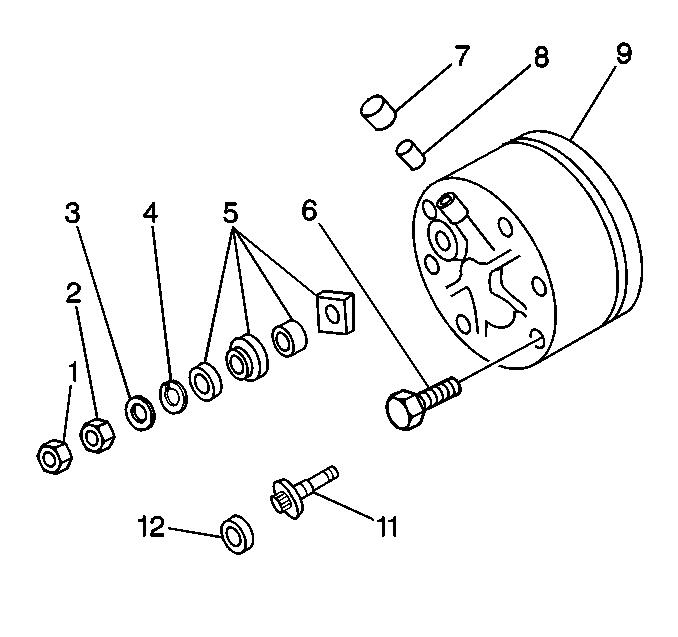
- Remove the following components
from the end frame:
| • | The terminal insulator (5) |
| • | The square insulator is located inside the end frame. |
- Remove the thermostat retaining ring (12) from the thermostat (11)
on starters with overcrank protection.
- Remove the four end frame screws (6).
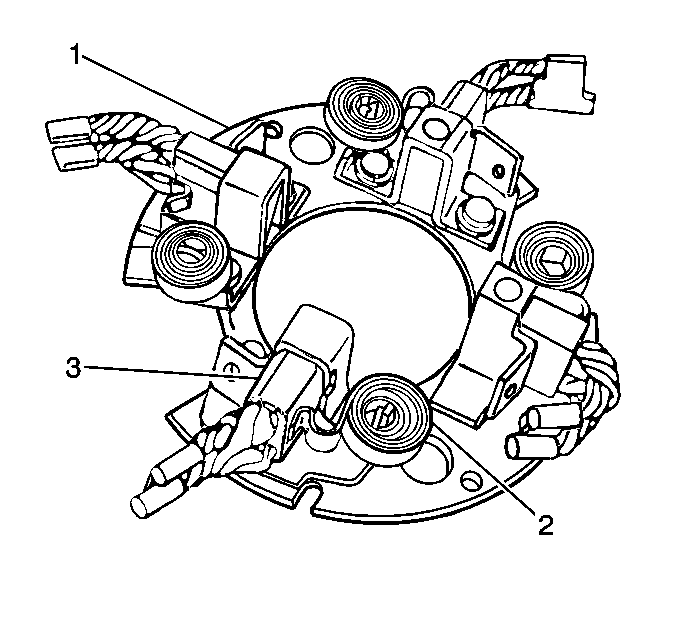
- Remove the end frame from
the field frame.
Hold the end of each brush spring (2) off the end of each brush (3)
while pulling the brush out of the guide. Only pull the brush out of the
guide enough in order to rest the spring against the side of the brush.
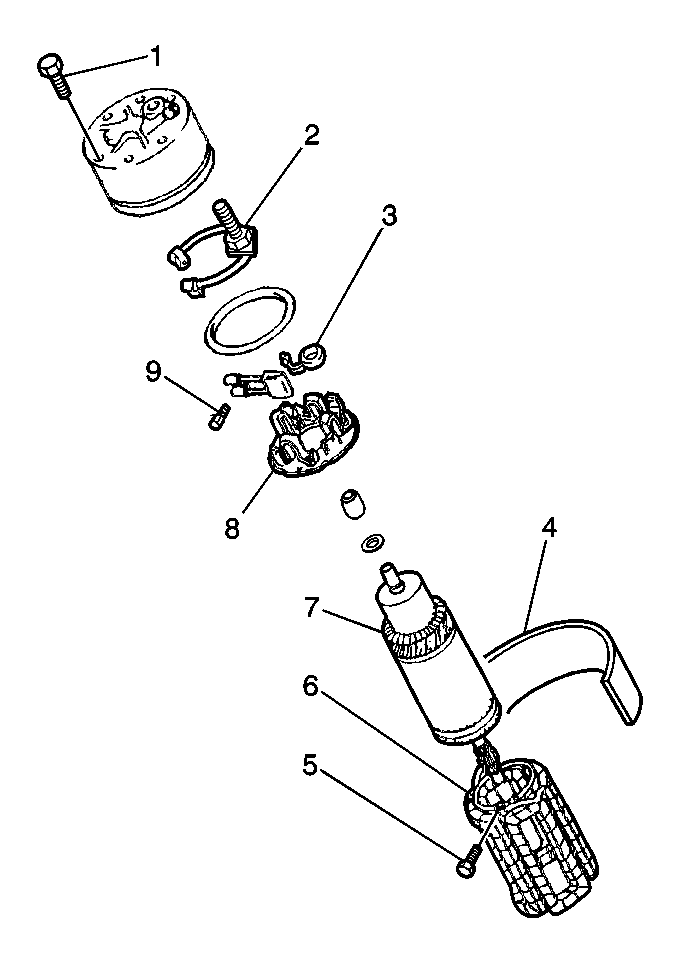
- Remove the brush attaching
screws (9) from the positive (insulated) brushes and field coil leads.
- Remove the brush plate assembly (8) and the terminal lead (2)
from the field frame.
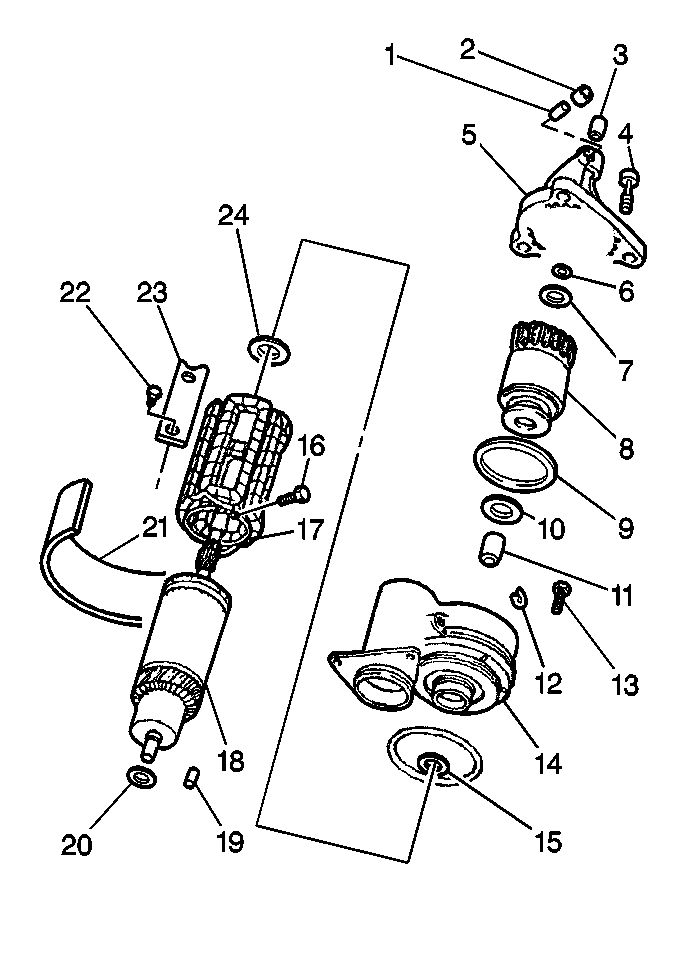
- Remove the drive housing
screws (4).
- Remove the drive housing (5).
- Remove the lever housing O-ring (9).
- Remove the five lever housing screws (13).
- Remove the lever housing (14).
Pry the lever housing away from the field frame.
- Remove the armature (18).

- Perform the following
procedure in order to remove the retainer ring and the pinion stop
from the armature shaft:
| 16.1. | Slide a metal cylinder (1) onto the armature shaft. |
| 16.2. | Use a hammer in order to strike the metal cylinder against the
retainer ring. |
| 16.3. | Use pliers in order to remove the snap ring (2) from the
groove in the shaft. |
If the snap ring becomes distorted during removal, replace the snap
ring.

- Remove the pinion stop (11)
from the armature shaft.
- Remove the thrust washer (20) from the commutator end of
the armature shaft.

- Remove three solenoid
to lever housing screws (3).

- Remove the solenoid (1).
Lever Housing Disassembly
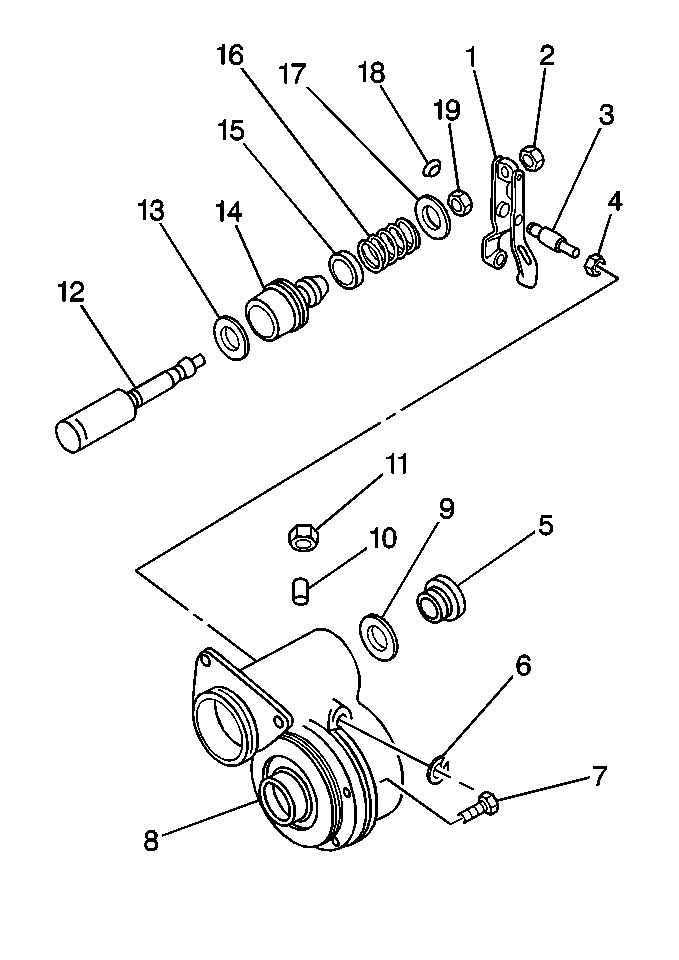
- Remove the inspection plug (5) from the lever housing (8).

- Remove the drive assembly (2) from
the lever housing (1).

- Remove the shaft retainer ring (6) from the lever housing at the end
of the shift lever shaft (3).
Important: The retainer will bend during removal. Do not reuse the retainer.
- Remove the shift lever shaft (3).
- Remove the shift lever (2).
Field Coil Disassembly

Important: Inspect the field coil for grounds before removing the coil from the
frame. Refer to
Starter Motor Inspection
. Grounds may not appear after the field coil is removed.
- Remove the outer insulator (7) from the field frame.

- Remove the pole shoe screws (22) from
the field frame, including the frame grounding terminal 16 (if present).
- Remove the field coil insulator (21).
- Remove the following components from the field frame:

- Remove the inside insulator (6)
from the field terminal on the field coil.
Solenoid Boot Disassembly

- Remove the plunger spring retainer ring (19) from the plunger shaft (12).
- Remove the following components:
| • | The plunger spring retainers (15,17) |
- Remove the plunger boot (14).
Solenoid Disassembly

- Remove the two cover attaching screws (19).
- Remove the nuts (15, 16, 17) and the washers (21,
20) from the terminal studs.
- Remove the cover (1).
- Remove the solenoid contact (10).
- Remove the cover gasket (3).
- Inspect the gasket for damage. Replace the gasket if necessary.
- Inspect the following components for wear, corrosion or dirt:
| • | The bottom of the contact return stud (4) |
- Clean the contact points on the contact plate and the bottom of
the studs.
Solenoid Assembly

- Install the gasket (3).
- Install a new contact (10) and studs (4, 5,
24) if necessary.
- Install the cover (1).
Notice: Use the correct fastener in the correct location. Replacement fasteners
must be the correct part number for that application. Fasteners requiring
replacement or fasteners requiring the use of thread locking compound or sealant
are identified in the service procedure. Do not use paints, lubricants, or
corrosion inhibitors on fasteners or fastener joint surfaces unless specified.
These coatings affect fastener torque and joint clamping force and may damage
the fastener. Use the correct tightening sequence and specifications when
installing fasteners in order to avoid damage to parts and systems.
- Install two solenoid
screws (19).
Tighten
Tighten the solenoid screws to 3.5 N·m (30 lb in).
- Install the nuts (16, 17, 18) and the washers (20,
21, 22) to the studs (4, 5, 6, 24).
Solenoid Boot Assembly

- Install a new boot (14) on the plunger (12).
- Install the following components onto the plunger (12).
| • | The spring retainer (15) |
| • | The spring retainer (17) |
| • | The retaining ring (19) |
Field Coil Assembly

- Install the inner insulator to the field coil terminal (17).
- Use a pole shoe spreader if necessary in order to install the
field coils (17) and the pole shoes (23) into the field frame.
If the pole shoe has a long tip on one side and a short tip on the other
side, assemble the long tip in the direction of armature rotation. Refer to
the identification tag on the field frame for the direction of the pinion
rotation.
- Install the pole shoe screws (22) and the frame ground
terminal (16) (if used) through the field frame and into the pole shoes.
Finger tighten the pole shoes in order to allow insertion of the field
coil insulator (21).
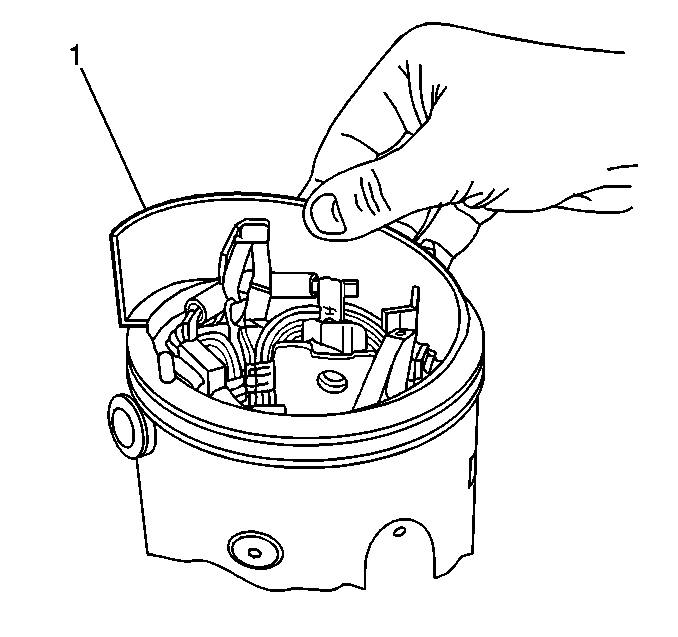
Notice: Use the correct fastener in the correct location. Replacement fasteners
must be the correct part number for that application. Fasteners requiring
replacement or fasteners requiring the use of thread locking compound or sealant
are identified in the service procedure. Do not use paints, lubricants, or
corrosion inhibitors on fasteners or fastener joint surfaces unless specified.
These coatings affect fastener torque and joint clamping force and may damage
the fastener. Use the correct tightening sequence and specifications when
installing fasteners in order to avoid damage to parts and systems.
- Install the field
coil insulator (1) to the left field frame.
Tighten
Tighten the pole shoe screws and the frame ground terminal (if used)
to 45 N·m (33 lb ft).
- Install the outer field coil terminal insulator to the field frame.
Starter Motor Unit Assembly

- Install the shift lever (2) in the lever
housing (8).
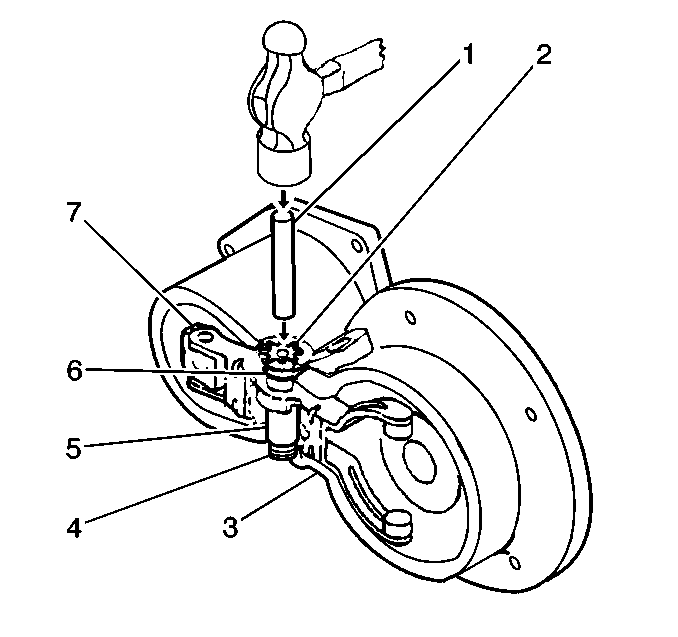
- Use the following procedure in order to install
the shift lever shaft (5) in the lever housing (3):
| 2.1. | Use the shaft retainer (2) in order to secure the shift
lever shaft. |
| 2.2. | Verify that the lever shaft is fully seated in the housing. Support
the housing. Use a 3/8 inch driver (1) and a hammer in order to drive
the retainer snugly against the end of the shift lever shaft. |

- Install the inspection plug (5) to the
lever housing (8).
- Install the solenoid plunger shaft (12) through the shift
lever trunnion (6).
- Install the plunger adjuster nut (1) to about the same
position on the shaft as prior to disassembly.

- Install new seals in the armature end of the
lever housing as necessary.
- Lubricate the armature and lever housing spacer (24). Refer
to
Starter Motor Inspection
.
- Install the spacer (24) onto the armature shaft.
- If the lever housing bushing (11) is being replaced, lubricate
the new wick and the new bushing. Refer to
Starter Motor Inspection
.

- Install the following components:
- Install the lever housing onto the armature shaft and field frame.
Be sure to align the marks scribed during disassembly.
Notice: Use the correct fastener in the correct location. Replacement fasteners
must be the correct part number for that application. Fasteners requiring
replacement or fasteners requiring the use of thread locking compound or sealant
are identified in the service procedure. Do not use paints, lubricants, or
corrosion inhibitors on fasteners or fastener joint surfaces unless specified.
These coatings affect fastener torque and joint clamping force and may damage
the fastener. Use the correct tightening sequence and specifications when
installing fasteners in order to avoid damage to parts and systems.
- Install the five
lever housing mounting screws.
Tighten
Tighten the lever housing screws to 20 N·m (15 lb ft).

- Install the following components onto the armature
shaft (18):
- Install the pinion stop (7).
The flat side of the pinion stop must face toward the pinion.
- Place the retaining ring (6) on the end of the shaft.

- Use a light
hammer blow against a wood block on top of the retaining ring in order to
force the ring onto the shaft.
- Slide the ring down into the shaft groove.

- Tap the pinion stop (7) up over the retaining
ring (6).
- If replacing the drive housing bushing (3), lubricate the
new wick and the new bushing. Refer to
Starter Motor Inspection
.
- Install the following components into the drive housing (5):
- Install the drive housing (5) into the lever housing (14).
Be sure to align the marks scribed during disassembly.
- Install the drive housing mounting screws (4).
Tighten
Tighten the drive housing mounting screws to 24 N·m (18 lb ft).
- Install the thrust washer (20) onto the armature shaft
at the commutator end.

- Perform the following procedure in order to install
the new brushes (3), if needed, and springs (2) to the brush
plate assembly (1):
| 24.1. | Install each brush spring in the following manner: |
| • | The plate assembly post is inside the innermost loop of the spring. |
| • | The free end of the spring is located toward the center of the
plate assembly. |
| 24.2. | Place the brush into the holder in the plate assembly in the following
manner: |
| • | The flat side of the brush clip is down under the brush screw. |
| • | The plain end of the brush is even with the bottom of the holder. |
| 24.3. | Use needle nose pliers in order to pull the free end of the brush
spring past the holder and place the spring against the side of the brush. |
The above action will hold the brush in a retracted position for further
motor assembly.

- Use the brush attaching screws (9) in
order to install the terminal assembly (2) and the thermostat (if
present) to the grounded (negative) brush holders and the brush leads.
Place the terminal leads between the brush holders and the brush clips.
Tighten
Tighten the brush attaching screws to 3.4 N·m (30 lb in).
- Install the brush plate assembly (8) to the field frame.
- Use the brush attaching screws (9) in order to install
the field coil leads to the grounded (negative) brush holders and the brush
leads.
Place the field leads between the brush holders and the brush clips.
Tighten
Tighten the brush attaching screws to 3.4 N·m (30 lb in).
- Perform the following procedure in order to release the brushes
onto the commutator:
| 28.1. | Pull back each brush spring |
| 28.2. | Push each brush into the holder until the brush rests against
the commutator. |
Verify that the brushes move freely in the holders. Verify that the
brush tension holds the brushes flat against the commutator
| 28.3. | Release the spring onto the end of the brush. |
| 28.4. | Verify that the braided copper brush leads on the insulated (positive)
brushes do not touch any ground source around the brush holder. |
- If replacing the end frame bushing , lubricate the new wick and
the new bushing. Refer to
Starter Motor Inspection
.

- Install the following components into the end
frame (9):

- Install the end frame into the field frame.
Be sure to align the marks scribed during disassembly.
- Install the four end frame screws (1).
Tighten
Tighten the end frame screws to 5.6 N·m (50 lb in).

- Use three solenoid mounting screws (3)
in order to install the solenoid (4) to the lever housing.
Tighten
Tighten the solenoid mounting screws to 18 N·m (13 lb ft).
- Inspect the mounting nuts on the large solenoid M and BAT terminals
in order to verify that the terminals are secure.
Tighten
Tighten the solenoid terminal nuts to 30 N·m (22 lb ft).
- Use two screws (1) in order to install the connector (8)
to the field terminal and the solenoid M terminal.
Tighten
Tighten the terminal screws to 3.4 N·m (30 lb in).
- Inspect the mounting nuts on the solenoid S terminal and ground
terminals (if present) in order to verify that the terminals are secure in
the cap.
Tighten
Tighten the solenoid terminal nuts to 3.0 N·m (27 lb in).

- If a ground lead is used between the solenoid
terminal and the commutator end terminal (type 350 only), inspect the nut (2)
on the ground lead to the solenoid ground terminal.
- Hold the mounting nut (next to the cap) in order to prevent the
mounting nut from turning when tightening the outer terminal nut.
Tighten
Tighten the terminal nut to 3.0 N·m (27 lb in).
- Install the thermostat retaining ring (12) to the thermostat
connector (if present).
- Install the commutator terminal mounting nut (1) to the
commutator end ground terminal.
Tighten
Tighten the mounting nut to 30 N·m (22 lb ft).
- Install a ground lead from the commutator end terminal to the
solenoid (type 350, if used) outer nut (1).
- Hold the mounting nut (next to end frame) in order to prevent
the mounting nut from turning when tightening the outer terminal nut.
Tighten
Tighten the terminal nut to 30 N·m (22 lb ft).



































